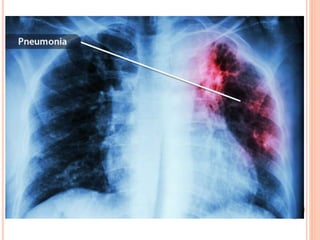The Respiratory system
- 1. The Respiratory System Presented by Amir Sami Effect of Covid-19 on
- 2. Breathing – Moving air in and out of the Lungs. Respiration – Chemical reaction that releases energy. Breathing and Respiration are NOT the same thing!
- 3. COVID-19 is a respiratory disease, one that especially reaches into your respiratory tract, which includes your lungs. What Does COVID-19 Do to Your Lungs? Nucleocapsid protein (N) and RNA Hemagglutinin esterase (He) Membrane protein (M)
- 4. COVID-19 can cause a range of breathing problems, from mild to critical. Older adults and people who have other health conditions like heart disease, cancer, and diabetes may have more serious symptoms.
- 5. CORONAVIRUS AND YOUR LUNGS SARS-CoV-2, the virus that causes COVID- 19, is part of the coronavirus family. When the virus gets in your body, it comes into contact with the mucous membranes that line your nose, mouth, and eyes. The virus enters a healthy cell and uses the cell to make new virus parts. It multiplies, and the new viruses infect nearby cells.
- 7. Think of your respiratory tract as an upside- down tree. The trunk is your trachea, or windpipe. It splits into smaller and smaller branches in your lungs. At the end of each branch are tiny air sacs called alveoli. This is where oxygen goes into your blood and carbon dioxide comes out.
- 8. Fever: 99% Fatigue: 70% A dry cough: 59% Loss of appetite: 40% Body aches: 35% Shortness of breath: 31% Mucus or phlegm: 27% Trouble breathing Constant pain or pressure in your chest Bluish lips or face Sudden confusion Common Symptoms Emergency Symptoms
- 10. Nose Mouth Nasal cavity Pharynx Epiglottis Larynx Trachea Organs Of Respiratory System oBronchus (bronchi) o Bronchioles o Alveoli o Pleura o Diaphragm Lungs
- 12. Brings air (O2) into the body. Carbon Dioxide leaves the body through the mouth and nose Nasal hairs in nostrils filter and trap dust. Air is not filtered as much when it enters in through your mouth. Mouth & Nose
- 13. Warms & moistens air. Glands that produce sticky mucus line the nasal cavity – traps dust, pollen, and other materials that were not trapped by nasal hairs – cilia sweep mucus and trapped material to the back of the throat where it can be swallowed Nasal cavity Nasal Pasage
- 14. Tube-like passageway used by food, liquid, and air At the lower end of the pharynx is a flap of tissue called the epiglottis – covers the trachea during swallowing so that food does not enter the lungs Pharynx (Throat)
- 16. “Voice box” The airway to which two pairs of horizontal folds of tissue, called vocal cords, are attached Larynx
- 17. Air-conducting tube Connects the larynx with the bronchi Lined with mucous membranes and cilia Contains strong cartilage rings which hold the trachea open. Without these rings your trachea might close off and air would not be able to get to and from your lungs. Trachea (Wind Pipe)
- 18. Two short tubes that branch off the lower end of the trachea Carry air into the lungs. Singular - bronchus Bronchi
- 20. bronchi tubes split up, like tree branches, and get smaller and smaller inside your lungs. The tiny branches of air tubes in the lungs are bronchioles Connect bronchi to alveoli Bronchioles
- 21. Tiny, thin-walled, grapelike clusters at the end of each bronchiole Surrounded by capillaries Where carbon dioxide and oxygen exchange take place Singular - alveolus Alveoli
- 22. Membrane lining the lungs and chest cavity. Pleura
- 23. Muscle wall between the chest and the abdomen that the body uses for breathing Lungs expand and contract in response to changes in pressure inside the chest cavity. The diaphragm flattens to cause the chest to expand and air is pulled into the lungs. When the diaphragm relaxes, the chest collapses and the air in the lungs is forced out. Diagphragm
- 25. Amir Sami
























